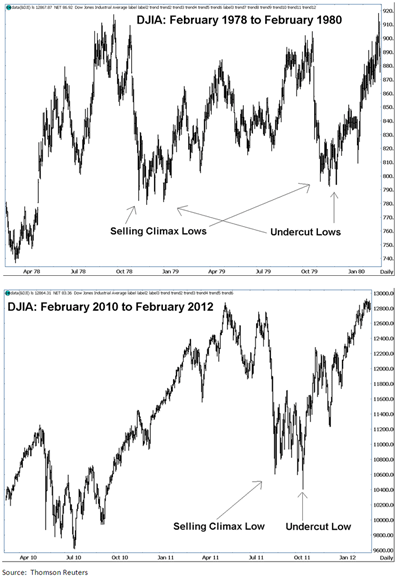Abbondanza!
by Jeffrey Saut, Chief Investment Strategist, Raymond James
February 21, 2012
“I got a call today I didn’t wanna hear but I knew that it would come ...”
... Don Henley; The Heart of the Matter – 1989
Said phone call was from one of our financial advisors who queried, “Hey Jeff, I agree with your short-term cautious stance so I want to know which index you would use to bet on the downside?” I responded, “I am not really interested in betting on the downside because while we could get a 5% - 8% pullback, we just as easily could see another one of these sideways consolidations where the overbought condition is worked-off and the stock market’s internal energy is rebuilt.” That’s pretty much the way it has been since my March 2, 2009 diatribe, “The stock market bottoms this week and we are all in.” While it is true I have gotten cautious a number of times since then, and actually raised some cash in March 2010 and again in March 2011, I have never retreated from the statement – don’t get bearish! Moreover, I have always recommended recommitting that cash when I thought we were near a downside inflection point; most recently, at the August 8, 2011 low and again at the October 4, 2011 “undercut” low.
Recall, I recommended raising cash in March 2011, believing a correction would be forthcoming. I had no idea it would be as severe as the ~20% affair we experienced. At the time I was using the analogues of the October 1978 and October 1979 declines, as well as their subsequent bottoming patterns. As can be seen in the attendant charts, those October declines came out of the blue, lasted two to three weeks, and initially ended with a “selling climax.” From there the D-J Industrial Average (INDU/12949.87) “bobbed and weaved” for six to eight weeks while the bottoming sequence developed, punctuated by two “undercut lows” (slightly below the selling-climax low); and that was it, the bottom was “in.” Now, study the second chart of last year’s pricing action. What you find is a sharp two-week decline ending with the August 8th “selling climax,” which was historic. In fact, to find another session like August 8, 2011, where less than 2% of all stocks traded were “up” on the day, you have to go back to May 13, 1940 when the German army punched a 60-mile wide hole in the Maginot Line and invaded France, but I digress. The correlation (or R²) between the October 1978 and 1979 declines, and their subsequent bottoming sequences, and what occurred last year is uncanny with an R² of ~96%. This observation gave me the conviction to recommend buying the October 4, 2011 “undercut low” and I have stayed pretty constructive on stocks ever since.
The reasons for my optimism have been repeatedly chronicled in these comments. Firstly, three years ago I opined that productivity had leaped so much that any pick-up in the economy was going to translate into a profits explosion, leading to an inventory rebuild, then a capital expenditure cycle, followed by a gradual improvement in employment . . . Q.E.D. Secondly, valuations for the S&P 500 (SPX/1361.23) at the October 4th low were as parsimonious as they have been in decades with an equity risk premium of more than 8%. To be sure, the major averages have resided below their median P/E ratio for the longest stretch since the 1970s. Thirdly, no recession; and Euroquake will not pull us into one (this morning we have a short-term Greek “save” as I have been suggesting would be the case). Fourth, the intangible capital theme whereby our economy looks a lot better than thought when viewed through the “lens” that companies in America are accumulating $1.5 trillion of intangible capital a year and it is not being accounted for on corporate financial statements (nor is the stock market ascribing any value to it). Fifth, there is a movement afoot that is sparking a change in Congress’ constituency where practical people are being elected and not professional politicians. Sixth, a world that is profoundly underinvested in U.S. equities. Meanwhile, there are a lot of good macro things happening.
In addition to the theme that technology is making building more for less a reality, other themes I am encouraged by include: companies making products for American consumption are moving jobs back to the U.S.; the reindustrialization of America; Americanism; a move toward energy self sufficiency that will shrink our trade deficit; and then there are the themes outlined in the book Abundance: Why the Future Will Be Much Better Than You Think written by Peter H. Diamandis and Steven Kotler. The book was referenced in a Forbes article dated February 13th. To wit:
“A quick glance at the headlines lets us know the score: dark days ahead. With growing concerns about population size, economic meltdowns, energy shortages, water and food shortages—this list goes on—alarmists are having a field day. For the first time in a long time parents are predicting a worse life for their children than their own. Yet nothing could be further from the truth. We are now entering a period of radical transformation. Progress in artificial intelligence, robotics, infinite computing, ubiquitous broadband networks, digital manufacturing, nanomaterials, synthetic biology and many other breakthrough technologies will let us make greater gains in the next two decades than we’ve made in the previous 200 years. We will soon have the ability to meet and exceed the basic needs of every man, woman, and child on the planet. Abundance for all is within our grasp.”
The article goes on to explain, “If that sounds like hogwash, there are good neurological reasons for this reaction.” It seems our brain is wired wrong to process the deluge of data being thrown at it. Indeed, our brain evolved in an era of immediacy, when threats like “the tiger in the bush” abounded. Today’s dangers, however, are more probabilistic – terrorists may attack, the stock market might crash, Iran could block the Hormuz Straits, a depression, etc. Regrettably, our brains can’t tell the difference between “immediate” and “probabilistic” threats. Even worse, our brain stays engaged in the perceived threat until it vanishes, but probabilistic dangers never completely vanish. Yet, the world is not the nightmare that the media bombards our brains with constantly. Child mortality has fallen 90%, life spans have increased 100%, food is cheap and plentiful, adjusted for inflation, incomes have tripled over the past 50 years, and even folks living below the poverty line have access to telephones, toilets, TV, water, etc. Nor are these metrics just centered in the developed world.
Forbes concludes the article with four powerful forces possessing the potential to enormously change the world. First, information-based technologies are on an exponential growth curve. That rate of change is showing up in networks, sensors, cloud computing, 3-D printing, genetics, artificial intelligence, robotics, and dozens of more industries. Second, the do-it-yourself innovators (DIY) have moved into neuroscience, biology, genetics, robotics, etc. – hello Dean Kamen, the greatest DIYer of all time. Third, money, and a lot of it, as the high-tech revolution has created tens-of-thousands techno-philanthropists who are using their wealth to solve the world’s issues. Lastly, the world’s poorest people are plugging into the global economy via the Internet, and wireless communication, technologies. This is raising their standard of living. Consequently, the law of large numbers tells us these Rising Billions are in the same category as exponential technology, the DIYers, and the techno-philanthropists. As Forbes notes, “Over the next decade 3 billion new voices will join the global conversation. What will these people desire? What will they create?” Verily, these forces, acting in concert, have the ability to change the world; and change it profoundly for the better.
The call for this week: Despite overbought conditions, a Dow Theory upside non-confirmation, the end of the “buying stampede” on January 26th, a stock market that has used up most of its internal energy in the short-term, a massive downside reversal from Wall Street’s premier stock last Wednesday (AAPL/$502.12), saber rattling in the Hormuz Strait, a ~21% rise in the price of gasoline since mid-December, et all the stock market has trudged higher. Manifestly, the SPX has now gone 35 trading sessions in 2012 without suffering a 1% down day. There have been 12 other years since 1928 where the SPX has traded higher for 30 sessions, or more, without a 1% down day. In all but one of those occurrences the SPX was higher at year’s end with a median gain of more than 15%. That’s yet another positive harbinger for the rest of this year. Nevertheless, for the past few weeks the rise has felt unnatural to me, which is why I have been cautious, but not bearish. Because of that caution, I have been featuring more conservative, dividend-paying, stocks that are favorably rated by our fundamental analyst. In last Monday’s missive I mentioned: Abbott Labs (ABT/$56.36/Outperform); AFLAC (AFL/$48.01/Outperform); Chevron (CVX/$106.66/Strong Buy); McDonald’s (MCD/$99.99/ Outperform); and Norfolk Southern (NSC/$68.81/Strong Buy). As well, I particularly emphasized CenturyLink (CTL/$39.26/Strong Buy), which was timely according to my proprietary algorithms and ready to break out to the upside in the charts, which it did. This week my algos are targeting 2.6%-yielding Huntington Bancshares (HBAN/$6.09/Strong Buy). For further information please see our fundamental analysts’ most recent reports.

Click here to enlarge













